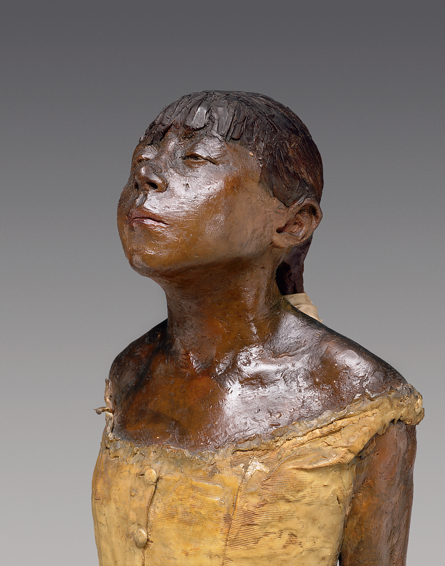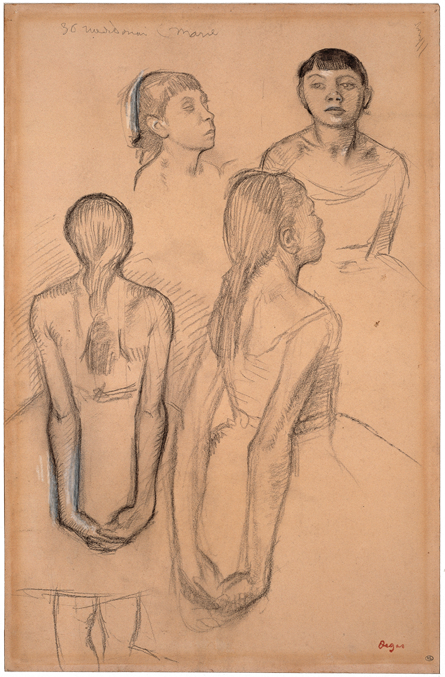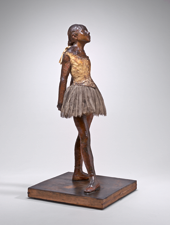Despite its fame, Little Dancer’s original appearance is inadequately documented. No images of the wax from Degas’s lifetime, even caricatures, have been found, so scholars have long relied on critical reviews, related drawings, and the inventory photographs taken forty years after its exhibition. Thus we begin with the textual evidence and a historical analysis of individual elements, some as revealed by Sturman and Barbour in the Technical Notes above.
Figure and Costume
Typical of Salon criticism, descriptions of Little Dancer in 1881 vary from one another and from other period documents, presenting a problem in using them as evidence. For example, though the catalogue defines the figure as a wax statuette, Bertall labels it a terra-cotta.[1] Some call the wax lifelike, despite its small size, especially in its modeling, materials, and color. The vague descriptions of the figure’s skin suggest she was not fair: Mantz claims her unwashed appearance went far beyond the shiny pink freshness of a window mannequin even for natural-ist accuracy.[2] Little Dancer’s present color is a dark honey, with areas of dark overpaint, but the pink tint on her lips and ears, visible at close range, imparts the “living” effect of coursing blood to the translucent wax.[3]
This figure’s dark blond Caucasian human hair indicates it is more “real” than Huysmans’s famous description of it as of horse hair.[4] Critics’ mention of a hair ribbon corresponds with the inventory photograph, but certain critics also record ribbons elsewhere on her body: Huysmans describes a matching companion at her neck, and Mantz, a blue ribbon around her waist.[5] These are possible errors since there are no imprints of such elements on the dancer’s neck or waist (unlike the impression of a grosgrain ribbon visible in her hair, noted in the Technical Notes), and no such details in the inventory photographs, though several drawings represent a band at the waist (fig. 1). If the wax originally bore these accessories, however, it was more elaborately adorned (like some dancers in Degas’s paintings) than ever thought, but simplified by the time it was photographed following Degas’s death.
The statuette’s costume seems to combine apparel for performance and work in a way that departs from examples seen in period documents. The linen slippers, pigmented pink by the wax, are most similar to work models, described in memoirs as of pink or gray cotton ticking (coutil ) rather than sheathed in dyed satin like a performance shoe.[6] Comparison with nineteenth-century examples suggests that they are commercial products (perhaps a child’s, as mentioned in the Technical Notes above) modified at the heel to fit the wax.[7] The pair on Little Dancer is half-prepared for use: it includes the ankle ribbons that dancers themselves add, but not their darning to reinforce the soft toe for pointe work.[8] Two critics correspondingly describe the figure’s outfit as work attire, with a bodice of modest cotton ticking (de Villars) in white (Huysmans).[9] The tutu, which most chroniclers only summarily describe as of “real” muslin, gauze, or tarlatan, and “cheap,” further suggests a working tutu that loosely corresponds to de Mérode’s description.[10]
Yet this figure lacks the loose bloomers to the knees typically found under a nineteenth-century work tutu.[11] Visible in many of Degas’s paintings and in photographs of the period, such pantaloons are not documented for Degas’s Little Dancer at any point, and there are no imprints on the wax to suggest they were originally present. The “culottes” formed by the bottom layers described in the Technical Notes instead resemble de Mérode’s underskirting for performance.[12] The wrinkled impressions of leggings on the dancer suggest the corresponding silk tights for performance, not the heavy work stockings that stopped, gartered, above the knee; in fact, the wax’s modeling and tooling to simulate tights continues to the top of the thigh.[13] Whatever Degas’s aim in eschewing the modest (and warm) baggy reality, the figure’s departure from historical fact and drawings related to the project simplifies the sculpture formally, seeming to clarify the anatomy and pose.
The tutu’s length, density, and transparency are crucial to its appearance. The present skirting, described in the Technical Notes, is widely considered not the original, but the history of the tutu at any point is especially murky. The dates given for possible changes, though, are often based on questionable information. Recent scholars see Hébrard’s call for a new tutu in 1919 as a sign that it was provided.[14] When exhibited in 1921 and 1924, however, the wax’s tutu was reported as so blackened and tattered that observers likened it to an ancient Egyptian mummy’s shroud.[15] Kendall points to the 1924 account, which claims the “costume” was “renovated without error” twice after 1881, to propose the tutu was replaced twice.[16] Although the 1924 article is the most direct statement about any changes to Little Dancer’s apparel known so far, it is open to debate before other evidence: in the Technical Notes above, Sturman and Barbour speculate that the present layers might include the original.

Fig. 3: Degas, Little Dancer Aged Fourteen, three-quarter view of head
Pose
The dancer stands in a pose sometimes called a casual fourth,[26] arms extended downward behind her, hands clasped. Her head juts forward and upward, face impassive but the mouth slightly open, and eyelids half-lowered over eyeballs with delicately incised pupils that focus downward (fig. 3). In most light, the pupils are almost invisible, the heavy-lidded eyes suggesting unreadable withdrawal. When the pupils are visible, however, her focus changes according to the height at which the figure is set, affecting interpretation of the action. Set at or slightly above the viewer’s eye level, her face tilts up beyond us but her gaze meets ours; set lower, her face meets us but her eyes evade. There is no hard evidence for any planned viewing angle for the sculpture.[27]
Little Dancer’s subtly vibrant stance has prompted several interpretations over the years. Gsell describes a “neophyte” embarking, as if possessed, on her “initiation” into a cult of Terpsichore.[28] Others apply that sense of incipient movement and eerie psychological life to the modern dance world. For de Villars, the figure provides the dreary earthbound reality of her craft rather than the ethereal onstage fantasy; several critics describe her as stretching tiredly.[29]
For recent scholars, the gaze and projecting, uplifted head add a troubling psychological note.[30] Invoking the codified body language of pantomime for pride, Hargrove argues they suggest a smugness inappropriate even for an adolescent.[31] Reff claims the facial expression adds “a vaguely sensual yearning, especially in the half-closed eyes.”[32] For the dancer Wilfride Piollet, the sculpture represents the angel-beast, her bodice already half-opened to offer herself to an unknown standing before her.[33] These various readings reflect the broader debates about the figure’s meaning, to be presented below.
The “Glass Cage”
Degas provided the Little Dancer with a vitrine, now apparently lost, for display in two of the impressionist exhibitions, first in 1880, when the case was set up but the figure remained absent, and then in 1881, when the case was installed at the opening of the exhibition and the figure appeared two weeks later. Various critics made much of the vitrine. For some, it served as Little Dancer’s surrogate, standing empty in the galleries until she arrived. Once the sculpture was placed inside, certain opponents dubbed the case a “glass cage” (cage de verre) that reassuringly quarantined a dangerous child-beast or medical specimen.[34] For Callen, the case reinforced the figure’s reading as a scientific display rather than as art, since, she argues, small sculpture was not vitrined at the Paris Salon.[35] Small and especially fragile modern sculpture, like Little Dancer, however, appeared in cases in other exhibitions of contemporary art at the turn of the century.[36] Rather than clarify the sculpture’s content and relationship with the viewer, as a vitrine traditionally intended,[37] Degas’s glass cage contributed to the figure’s volatile meaning.
Notes
1. Bertall, "Exposition: Des Peintres intransigeants et nihilistes: 36, boulevard de la Capucines," Paris-Journal, April 21, 1881, 1.
2. Paul Mantz, "Exposition des oeuvres des artistes indépendants," Le Temps, April 23, 1881.
3. George T. M. Shackelford, Degas: The Dancers, exh. cat. (Washington, DC, 1984), 66; Patricia Failing, "Cast in Bronze: The Degas Dilemma," Art News 87, no. 1 (January 1988): 139.
4. Joris-Karl Huysmans, "L'Exposition des indépendants en 1881," L'Arte Moderne (1883), 227. The hair was identified as Caucasian human hair in Michael Palmer, Analysis Report, March 29, April 17, 2002, NGA conservation files. Charles W. Millard, the Sculpture of Edgar Degas (Princeton, 1976), 39 n. 64, and Theodore Reff, Degas: The Artist's Mind (New York, 1976), 247 – 248, establish a tradition that the wig came from a wigmaker for dolls and mannequins (a Mme Cusset) listed in the same notebook with Marie Van Goethem’s address, an association that remains speculative.
5. Huysmans, "L'Exposition," 227; Mantz, "Exposition des oeuvres"; Our Lady Correspondent, unsigned and untitled review, Artist 2 (May 1, 1881): 42. Our Lady Correspondent describes the hair ribbon as emerald in color; Huysmans claims it matches a neck ribbon that is leek-colored (porreau [or poireau]).
6. Cléo de Mérode, Le Ballet de ma vie (Paris, 1955), 37.
7. Though a nineteenth-century work slipper has yet to be found, this pair is technically consistent with performance types except for the simple diagonal cut at the heels, rather than the typical double-stitched vertical seam there. That anomaly also argues against their being custom-made for Degas. The possibility that they are a child’s slippers derives from their size: at 15.5 cm, they are only 7 cm shorter than certain nineteenth-century ballerina’s slippers at 22.3 cm, including the example found in Degas’s studio.
8. Notably, de Mérode, Le Ballet de ma vie, 37.
9. Nina de Villars, "Variétés: Exposition des artistes indépendants," Le Courrier du Soir, April 23, 1881; Huysmans, "L'Exposition," 204. Sample analyses show unpigmented yellow wax. De Mérode, Le Ballet de ma vie, 35, describes the bodice of the work outfit as of batiste, edged with ruffles around the neckline.
10. de Mérode, Le Ballet de ma vie, 36, describes the work tutu as of coarse tarlatan in only two layers, stiffened with a special compound, stitched together at the top and belted to flare into a layered ring. One problematic source, Pierre Michaut, "Immortalized in Sculpture: The Story of Louise Van Gothem," Dance Magazine 38, no. 8 (August 1954): 28, claims the wax’s original tutu was made by an Opéra dancer, Jeanne Schwartz, from a remnant of that of her niece Solange Schwartz, later an Opéra étoile.
11. Paul Mahalin, Ces demoiselles de l'Opéra (Paris, 1887), 47; de Mérode, Le Ballet de ma vie, 35.
12. Ibid., 36.
13. For discussions of tights and stockings, see cats. 22 and 38 [in the printed catalog Edgar Degas Sculpture].
14. Most notably, Alison Luchs, "The Degas Waxes, c. 1878–c. 1911," in Art for the Nation: Gifts in Honor of the Fiftieth Anniversary of the National Gallery of Art, exh. cat. (Washington, DC, 1991), 182. Hébrard’s report is conveyed by Mary Cassatt to Louisine Havemeyer, December 8, 1919, in Michael Pantazzi, "The Little Fourteen-Year-Old Dancer: Cat. nos. 223–227," in Jean Sutherland Boggs et al., Degas, exh. cat. (New York and Ottawa, 1988), 351. Anne Pingeot, Degas: Sculptures (Paris, 1991), cat. 73, additionally claims the wax’s tutu was changed in 1958, like Orsay’s bronze; see Pinasa, in Martine Kahane et al., "Enquête sur la Petite Danseuse de quatorze ans de Degas," 48/14: La Revue du Musée d'Orsay, no. 7 (Autumn 1998): 63. As Sturman and Barbour state in the Technical Notes, the Mellon staff claims the tutu is the one it bore when Paul Mellon bought it in 1956, therefore putting into question a tutu change in 1958 when the piece had already left France.
15. François Fosca, "L'Actualité: Degas, sculpteur," L'Art et les Artistes, June 1921, 374; Richard Kendall, Degas and the Little Dancer, exh. cat. (New Haven and London, 1998), 42 n. 92, which cites an undated clipping that refers to the 1924 exhibition at Galerie Georges Petit and Hébrard from April 12 to May 2, 1924. An original impression of the newspaper clipping is in the Musée d’Orsay, Paris, Fonds Fevre.
16. Kendall, Degas and the Little Dancer, 42 n. 92, using the above clipping, reputedly a conversation about the exhibition between Hébrard and the anonymous columnist.
17. Huysmans, "L'Exposition," 227, describes the tutu metaphorically, as surmounting the dancer’s legs “as if on a pavilion” (comme d’un pavillon).
18. For others, see Kendall, Degas and the Little Dancer, cats. 35, 41, repro.
19. See Kahane et al., "Enquête," figs. 3, 9 – 13, 17, 18.
20. Kendall, Degas and the Little Dancer, cat. 41, repro. For varieties of actual work tutus of c. 1895, see Kahane et al., "Enquête," fig. 11.
21. Bertall, "Exposition: Des Peintres intransigeants et nihilistes: 36, boulevard des Capucines," Paris-Journal, April 21, 1881, 1.
22. Huysmans, "L'Exposition," 227; Charles Ephrussi, "Exposition des artistes indépendants," La Chronique des Arts et de la Curiosité, April 16, 1881, 126.
23. Kendall, Degas and the Little Dancer, 42; idem, "Tutu Wars," Art Newspaper 89 (February 1999).
24. Ibid. For issues surrounding Orsay’s bronze, see Pinasa, in Kahane et al., "Enquête," 63 – 66.
25. Kendall, "Tutu Wars"; Pinasa, in Kahane et al., "Enquête," 64.
26. Most recently, Jill DeVonyar, "Degas as Documentation: Edgar Degas' Annotated Drawings as Records of Late-Nineteenth-Century Ballet Practice," Proceedings: Society of Dance History Scholars Twenty-Fifth Annual Conference, 25–30 (Riverside, CA, 2002), 26.
27. Reff, Degas: The Artist's Mind, 245, argues that the downward angle upon the live model in various related drawings suggests a low viewpoint on the sculpture; however, the drawings render several perspectives, some moderately downward and some straight on. Anthea Callen, The Spectacular Body: Science, Method, and Menaing in the Work of Degas (New Haven and London, 1995), 22 n. 76, also notes the drawings typify Degas’s studio experiments with angled perspectives. She also rightly argues that typical gallery installation height for small figures then was about eye level. See Alain Beausire, Quand Rodin exposait (Paris, 1988).
28. Paul Gsell, "Edgar Degas, statuaire," La Renaissance de l'Art Française et des Industries de Luxe, December 1918, 376.
29. de Villars, "Variétés," 2; Ephrussi, "Exposition," 126; Mantz, "Exposition des oeuvres." Our Lady Correspondent 1881 instead describes the figure as dancing, and Louisine W. Havemeyer, Sixteen to Sixty: Memoirs of a Collector, ed. Susan Alyson Stein (New York, 1993), 254, as saluting the audience.
30. DeVonyar, "Degas as Documentation," 26, instead suggests her slightly arched posture could indicate an exercise in deportment, about which little is known.
31. June Hargrove, "Degas's Little Dancer in the world of Pantomime," Apollo 147, no. 432 (February 1998).
32. Reff, Degas: The Artist's Mind, 246.
33. Wilfride Piollet, in Kahane et al., "Enquête," 67.
34. Mantz, "Exposition des oeuvres"; Comtesse Louise, "Lettres familères sur l'art: Salon de 1881," La France nouvelle, May 1–2, 1881, 3. For discussions of its possible appearance, see Reff, Degas: The Artist's Mind, 242.
35. Callen, Spectacular Body, 21 – 22.
36. Auguste Rodin’s small plasters appeared in a table case in his 1899 traveling exhibitions through Europe, and Medardo Rosso placed a small wax in a vitrine among his entries at the Paris Salon d’Automne in 1904. See Beausire, Quand Rodin exposait, fig. 37; Sharon Hecker, "Reflections on Repetition in Rosso's Art," in Harry Cooper and Sharon Hecker, Medardo Rosso: Second Impressions, exh. cat. (New Haven, 2003), fig. 42.
37. Catherine Chevillot, "Réalisme optique et progrès esthétique: La Fin d'un rêve," Revue de l'Art 104 (1994): 28.



